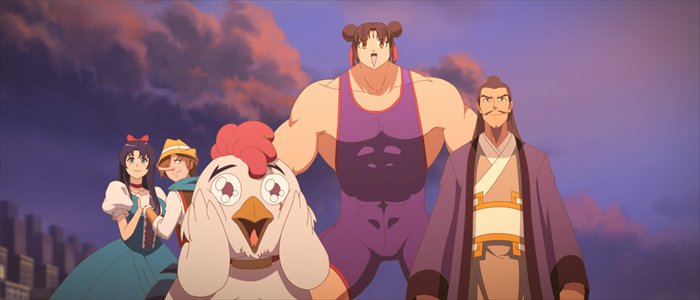Ode to animation
Chinese anime celebrates collective memories

A scene from One Hundred Thousand Bad Jokes Photo: CFP
When I walked out of the cinema after watching One Hundred Thousand Bad Jokes, the first thing I did was open WeChat and recommended it to my friends who were also animation fans. Watching the film felt like revisiting all the memories of the numerous animated shows and films I watched as a kid.
It is rare to see an animation studio not hype up its splendid 3D technology or how much they invested in visual effects when promoting their films. But there's no need for this type of hype with Bad Jokes, as the core part of the film is its story and characters. To tell the truth, before I walked into the theater I had a hard time imagining how a cartoon series consisting of a series of 10-minute shorts could be successfully turned into a 100-minute long film. However, I was pleasantly surprised as the film ended up telling a complete story while still managing to maintain the hectic original feel when it came to the characters in the comic book and online series.
Earning more than 100 million yuan ($16 million) since its premiere on December 31, Bad Jokes joins the ranks of high-earning IPs such as Pleasant Goat and Big Big Wolf and Boonie Bears. However while the latter two animated series are aimed at young children, Bad Jokes is mainly for adult audiences. As such, some netizens are hailing it as one of the first successful examples of an animated Chinese film for adults.
In this together
A successful online series and comic, crowdfunding for the film began in August of 2013, raising 1.37 million yuan from over 5,000 supporters on demohour.com. As one of these supporters (I donated 170 yuan), I received seven e-mails from the project inviting me to send videos to the staff and to attend some meetings to share ideas. This fan support can be seen in the film, as photos of supporters appeared on one of the character's computer screen and short videos of fans shouting out the name of the Chinese anime appear at the end of the movie. This sense of participation, certainly adds an extra layer of depth to the film that other movies lack.
Breaking the mold
My suggestion for anyone looking to see the film is to catch up on the online series first before heading to cinemas. Although the film features a complete stand-alone story for the big screen, you will have much more fun knowing why audiences are laughing at the idea of putting Snow White and Pinocchio together, as well as understand who the character of the legendary Mr. Kong is and why he is living together with a snake fairy.
The film is constantly taking things we expect from these types of stories and their characters and turning things on their head. For instance, the meat of the story is about a man who tried to save the world, but unfortunately ended up destroying it instead.
For those born during the 1980s and 90s in China, the film brings back memories of the times we were moved by the bravery of Nezha in the animated film Prince Nezha's Triumph Against Dragon King (1979) when we were very young as the film depicts a new version of Nezha with a muscular body and an adorably cute face. Meanwhile, Nezha's father will surprise audiences with his amazing but hilarious skills.
Other humorous changes include turning the magic mirror from the tale of Snow White into a smart tablet that takes forever to open and always scolds its owner for forgetting to turn it off.
Surprising details
There are lots of little details in the film for fans of animation. At one point before the world ends, a man wearing shorts and a straw hat just like the main character Luffy from One Piece can be seen shouting, "Now I'll never see the end of One Piece!" It's small details like these that want to make fans of the 17-year-old Japanese manga laugh out loud, or maybe even cry.
Call backs to Japanese robot anime such as Beast King GoLion (1981) and its US adaptation Voltron: Defender of the Universe (1984) are in the film as well, and when I watched the film the audience couldn't help but shout out along with the characters "Form the legs! Form the body and arms!" And my soda nearly shot from my nose when the last character shouted "And I'll form the tonsils!"
Other references to more modern fair is present as well. A Marvel-style beginning showing a quick flash of comic pages briefly fills in the story's background, and when one character puts on armor it reminds one of the recent Iron Man movies, but suddenly brings you back to Transformers when he tries to turn into a truck.
As a fan of the Japanese anime series Neon Genesis Evangelion (1995), I was more than excited to see so many details calling back to my favorite work. The ending song for Bad Jokes was definitely adapted from "Komm, süsser Tod" (Come, Sweet Death), an insert song from the animated movie The End of Evangelion in 1997. Meanwhile, Evangelion's "Absolute Terror Field" setting is also used in the Bad Jokes.
Lovers of animation will be able to find even more familiar details in the movie, including ones about Studio Ghibli, animator and manga artist Satoshi Kon and even more recently popular manga such as the Fate series. If you're a fan of animation, there are more than enough things to see that you'll still be finding new surprises to appreciate in Bad Jokes on a second or even third viewing.